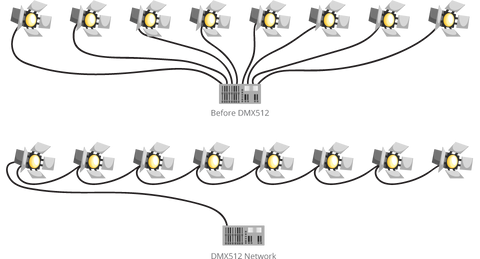You have no items in your shopping cart.
If are reading this article, I bet you have oodles of queries to meet on the topic. We have all answers you probably need on DMX Signals. First things first, what is DMX Signal? To make it a piece of cake, it is an “intelligent” system that controls lighting fixtures, dimmers and related accessories. Precisely, DMX or Digital Multiplex is an acronym for DMX512-A and is a standard for digital communication networks.
It was developed by the Engineering Commission of United States Institute for Theatre Technology (USITT). In 1986, the DMX512 standard was created for “Digital Multiplex” with 512 pieces of information. In 1990, following its popularity; further modifications led to the “USITT DMX512/1990”. The Entertainment Services and Technology Association (ESTA) brushed up the standard; that became legitimately recognized as "Entertainment Technology—USITT DMX512-A—Asynchronous Serial Digital Data Transmission Standard for Controlling Lighting Equipment and Accessories". In November 2004, it was sanctioned and standardized by the American National Standards Institute (ANSI). It was revised over in 2008 and the latest standard is known by "E1.11 - 2008, USITT DMX512-A", or "DMX512-A" to be short and precise. In January 2011, ESTA united with PLASA, an analogous organization in the UK. The new organization is called Plasa and it maintains all ESTA standards.
All the practical applications and pros of DMX Signals are jotted herewith. A widespread assortment of lighting control consoles, controllers and added devices that output DMX signals can be used to connect to a greater variety of lighting fixtures and accessories. It is the prime system for linking controllers such as a lighting consoles to dimmers and other special effects devices like fog machines and intelligent lights. DMX signal controlled lighting systems find application in many professional settings, namely concert lighting, stage lighting, studio lighting and theme park attractions. It has long-drawn-out to uses in non-theatrical interiors too. DMX signals have wide applications at scales ranging from strings of Christmas lights to electronic billboards.
In this modern era, the DMX standard is being used recurrently mainly in stage lighting, architectural lighting projects, counting from general purpose building management, illumination of building exteriors, accent lighting; to high-end residential lighting. This is largely due to the great acceptance of LED based lighting fixtures that are commonly controlled by DMX signals. These networks archetypally employ a wireless transmitter at the controller with tactically placed receivers near the fixtures to transform the wireless signal to orthodox DMX512 wired network signals. DMX512's reputation is partway owing to its sturdiness. The cables can be abused without a qualm about its functionality.
That is surely a lot of pros of DMX Signals. It has a few cons as well that cannot be overlooked. The DMX512 does not take in the automatic error checking and correction. This makes in inappropriate for controlling of precarious applications like pyrotechnics or movement of theatrical rigging. Another concern is false triggering; which is a result of electromagnetic interference, static electricity discharges, improper cable termination, excessively long cables, or poor quality cables.






